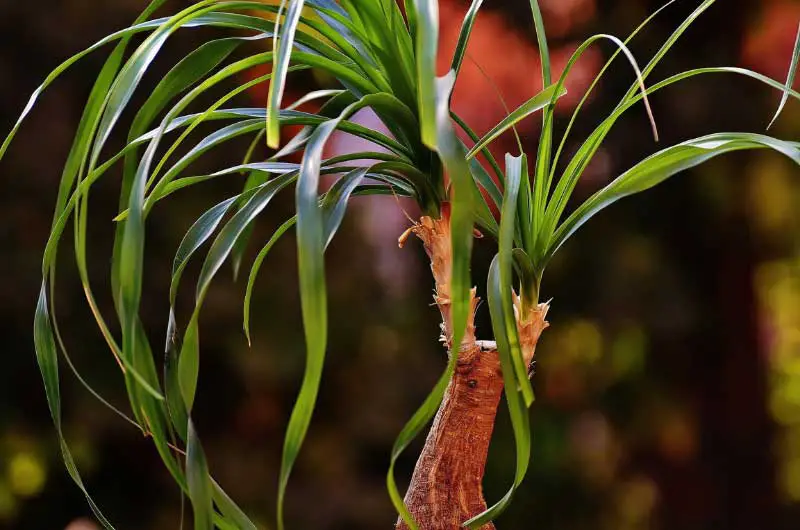How To Grow Multiple Trunks On A Ponytail Palm?
Ponytail palms are popular due to their fabulous look and minimal maintenance. People love to keep them as houseplants and plant their offsets each spring. Besides making your space green, they also make your living space aesthetic and trendy. But do not go by the name; it’s not a palm; it’s a succulent instead!
People might often try to grow many trunks on their parent Ponytail palms. Now, you may wonder if this is even possible?
Yes, you can stimulate the growth of many trunks on a Ponytail palm. All you have to do is cut the stem of the parent plant with the help of a sharp and sterile tool. Soon, the plant starts healing, and you see the pups/offsets developing roots. You can separate the offset from the parent plant and place them in another pot.
You can always try growing multiple trunks by different methods, but you may not succeed every time, and the results vary for every method. Nonetheless, in this process of experimenting, you will learn a lot about your plant.

Why should you grow multiple trunks on your Ponytail palm?
Multiple trunks mean you get more offsets to carry out further propagation. Also, you get to experiment with your plant and know its characteristics better.
- More baby plants– When you grow multiple trunks on your parent palm, you have a chance to propagate numerous offspring.
- You can experiment with your plant– Growing multiple trunks would be a learning experiment for you, and you will get to know more about your plant. And once this experiment of yours is successful, you can try growing the offspring in your next experiment.
- Bring them indoors– Ponytail palms may not do good in winters. It allows you to bring them indoors so they may relish the warmth and prosper. All you have to do is grow many trunks and bring those offspring indoors and repot them.
- Give them as a gift– Ponytail palms are one of the best things to give to plant lovers. Watering them once a week is enough to keep the plants healthy and happy. The multiple trunks allow you to get numerous offsets to gift for occasions such as thanksgiving, housewarming, or birthdays.
The lifespan of Ponytail palms
Though their growth rate is slow, the Ponytail palms can survive for decades. And don’t be surprised if they live for centuries. For this reason, they are a popular choice for all plant lovers.
What is the best time for growing multiple Ponytail palm trunks?
Growing seasons are the perfect time to grow, propagate,stem-cut or repot any plant.
The same applies to Ponytail palms. It is best to grow the trunks in the growing season i.e. the summer or winter season to get fruitful results. The plants take no time to heal, adjust or branch out.
These plants crave bright light and warm seasons; therefore, palms grow well in summers or at the onset of spring. It doesn’t like cold winters.
Methods for growing multiple Ponytail palm trunks
Growing multiple trunks is not a cakewalk. There are many risks involved, like you may damage or hurt the parent plant, or you may cut the trunk wrong. It requires patience and hard work. Read on to find out how we can grow many trunks successfully:
1. Cut the stem
This is the oldest and the most traditional method of growing multiple trunks. However, this method is not always successful but is worth trying.
When you cut their stem, the palms will produce baby plants at the stem’s base. The babies will grow at the base of the trunk. And there are high chances of them having roots. So you can directly repot these pups in a separate pot.
For stem cutting, go as advised:
- Select and prepare a particular area of the plant. Ensure to select a young and healthy plant.
- Wear gloves because your safety is essential as the edges of its leaves are razor sharp.
- Take a sterile and sharp tool such as a knife or trimming shears for stem cutting. A Sharp knife will exert minimum pressure on the plant while cutting so the cut will be smooth. Eventually, the plant will take less time to heal.
- Slightly concave cuts also aid in the quick healing of the plant.
- Keep an eye on your plant until it heals and the new trunk grows.
After a few weeks, you will notice small stems emerging around the trunk you cut. Also, there will be multiple trunks emerging from the soil.
2. Wait for the plant to bloom.
Another method to get multiple trunks is to wait until the Ponytail palm produces flowers. The stem will automatically bifurcate once the plant has produced flowers.
But remember, flowering takes time as long as 20-30 years. So only if your Ponytail palm is old you can wait for the stem to bifurcate and give many trunks.
If your palm is young and planted in a pot, the best way to produce multiple trunks is to cut the stem.
Varieties
There are three most recognized varieties, and the names are according to the shape of their leaves. These varieties are:
- Beaucarnea recurvata– The leaves are recurving and long.
- Beaucarnea stricta– As the name indicates, the plant has stiff or strict leaves.
- Beaucarnea gracilis– Their leaves are gracefully glaucous and thin.
Problems with your cheerful Ponytail palm
- Dried out and brown leaves/shriveled trunk caused due to underwatering.
- Curled leaves due to overexposure to sunlight.
- Mushy trunk or yellow foliage indicates overwatering of this succulent.
- Transplant shock results in stunted growth, yellowing or wilting of leaves.
- It may occasionally suffer pest infestation from mealybugs, spider mites, thrips, whitefly, aphids, blackfly, and scale. You can spray your plant with an insecticide for effective pest treatment.
- Their diseases are botrytis, root rot, leaf spots, southern blight, and powdery mildew.
- Molds, though, are harmless but give an unkempt look. So better remove them when noticed. They may develop either due to low light or overwatering.
Propagating a Ponytail palm
- You can quickly propagate them from seeds.
- If you want a more practical way, propagate it using a ‘pup’ or baby plant.
- This pup is produced on the plant itself.
- When this baby plant/pup starts developing roots, cut it from the parent plant using a knife. And grow it in a separate pot.
- Provide moist soil and enough water to this young plant until it develops a proper root system.
How to take care of your Ponytail palm?
When you cut the stem, the Ponytail palm becomes vulnerable to the attack of pests. And it takes a few weeks or a month to heal and produce new trunks. Therefore, you need to take special care of them to protect them from pests and diseases. Read on to find out how you can make your palm happy:
Provide adequate sunlight
Like any other succulent, Ponytail palms enjoy bright and direct sunlight. It is why they grow best on outdoor grounds.
But, while growing multiple trunks, keep the plants under indirect sunlight to prevent them from burning.
And, if you are growing them indoors, select the sunniest room of your house and keep them near the window. Because they can withstand dry conditions, they are a perfect choice for indoor plants.
However, these succulent plants do not like cold winters as much. This is why you should never try to grow multiple trunks in winters.
Choose the correct pot
These are like succulents and do not require much water. It means fast-draining soil works best for them. Therefore, you will have to choose a pot that allows faster drainage.
A 2-inches wide pot then their bulbous base would be best for them because they are comfortable in crowded and gritty soil.
Moreover, clay pots will help absorb excess moisture from their sidewalls. So you can consider putting your palms in clay pots.
Soil mixture
Ponytail palms are not fussy in terms of their choice for soil. They do exceptionally well in relatively dry soil, as the moist soil may cause their roots to rot. Therefore, gritty soil ensures proper drainage is well-liked by palms, just like cactus and other succulents.
You can prepare a suitable soil mixture for your plants. All you have to do is:
- Take potting mixture (1 part)
- Sand (1 part)
- Perlite (1part)
Mix them all, and your sandy soil mixture is ready.
Watering
As these plants are succulent, they do not need much water, prefer relatively dry soil, and don’t retain moisture.
Do not overwater Ponytails and prevent them from sitting in water. Else, it will lead to root rot.
Check 1-2 inches of soil before watering. Add water if you feel the soil dry; otherwise, wait for two days to water the plant.
You can prolong your watering schedule to 2-3 weeks in winters.
Add fertilizer
Like us, plants also enjoy a good feed. However, you should know when and which fertilizer to add to your plants.
It is advisable to add fertilizer a few weeks before cutting the stem.
And it is best to feed them in the spring. However, you can also add fertilizer at the onset of the growing season to enhance your plant’s growth.
You can use either organic or chemical fertilizers; it’s totally your call. But while using chemical fertilizers, remember to dilute them to half of their strength to avoid over-fertilizing.
You can also add Epsom salt (Magnesium Sulphate) to your palms to avoid magnesium deficiency. Epsom salt and palm fertilizer provide nutrients to palms to produce green, healthy leaves.
Optimum temperature
The Ponytail palms thrive well between the temperature range of 60-80°F. It means your plant loves springs and summers but may not prosper in winters.
In winters, provide it maximum warmth and avoid keeping it near windows. Else, the cold breeze might damage your plant.
Avoid pruning
Pruning is a big no for Ponytail palms because they are slow growers. You should not prune them unless you need to grow multiple trunks. It’s unlikely that the plant will overgrow, and you will have to prune it. So enjoy its aesthetic appeal as it is.
Final thoughts
Now you have in-depth knowledge about taking care of Ponytail palms and stimulating the growth of many trunks. Multiple trunks will give you many offsets that can grow into new green plant babies to give to anyone who loves plants.
You will love growing these cheerful succulents. These plants have swollen brown trunks that are smart enough to store water. With appropriate care, these plants show remarkable longevity. So gear up to make your home greener by growing these unique appearing and beautiful Ponytail palms.






